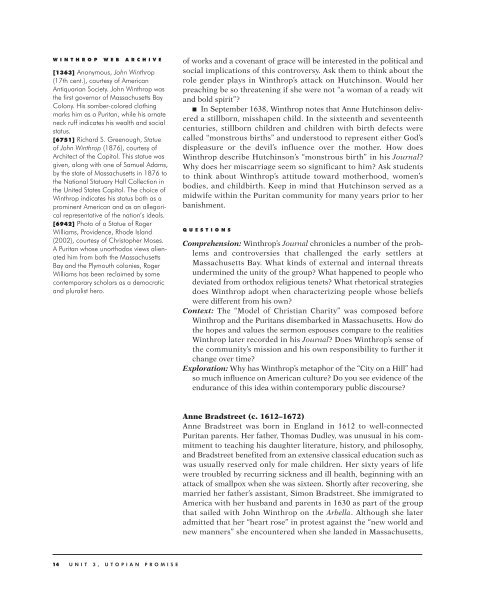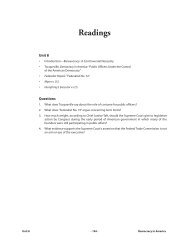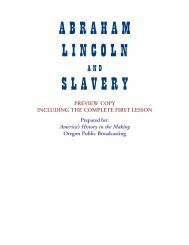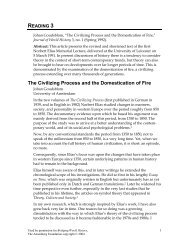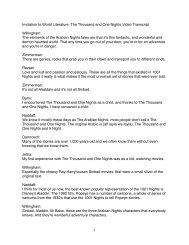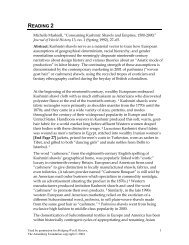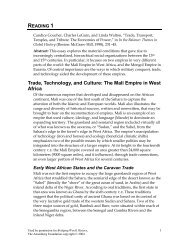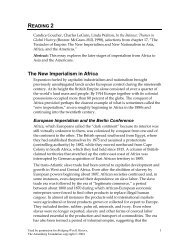UTOPIAN PROMISE - Annenberg Media
UTOPIAN PROMISE - Annenberg Media
UTOPIAN PROMISE - Annenberg Media
Create successful ePaper yourself
Turn your PDF publications into a flip-book with our unique Google optimized e-Paper software.
WINTHROP WEB ARCHIVE<br />
[1363] Anonymous, John Winthrop<br />
(17th cent.), courtesy of American<br />
Antiquarian Society. John Winthrop was<br />
the first governor of Massachusetts Bay<br />
Colony. His somber-colored clothing<br />
marks him as a Puritan, while his ornate<br />
neck ruff indicates his wealth and social<br />
status.<br />
[6751] Richard S. Greenough, Statue<br />
of John Winthrop (1876), courtesy of<br />
Architect of the Capitol. This statue was<br />
given, along with one of Samuel Adams,<br />
by the state of Massachusetts in 1876 to<br />
the National Statuary Hall Collection in<br />
the United States Capitol. The choice of<br />
Winthrop indicates his status both as a<br />
prominent American and as an allegorical<br />
representative of the nation’s ideals.<br />
[6942] Photo of a Statue of Roger<br />
Williams, Providence, Rhode Island<br />
(2002), courtesy of Christopher Moses.<br />
A Puritan whose unorthodox views alienated<br />
him from both the Massachusetts<br />
Bay and the Plymouth colonies, Roger<br />
Williams has been reclaimed by some<br />
contemporary scholars as a democratic<br />
and pluralist hero.<br />
14 UNIT 3, <strong>UTOPIAN</strong> <strong>PROMISE</strong><br />
of works and a covenant of grace will be interested in the political and<br />
social implications of this controversy. Ask them to think about the<br />
role gender plays in Winthrop’s attack on Hutchinson. Would her<br />
preaching be so threatening if she were not “a woman of a ready wit<br />
and bold spirit”?<br />
■ In September 1638, Winthrop notes that Anne Hutchinson delivered<br />
a stillborn, misshapen child. In the sixteenth and seventeenth<br />
centuries, stillborn children and children with birth defects were<br />
called “monstrous births” and understood to represent either God’s<br />
displeasure or the devil’s influence over the mother. How does<br />
Winthrop describe Hutchinson’s “monstrous birth” in his Journal?<br />
Why does her miscarriage seem so significant to him? Ask students<br />
to think about Winthrop’s attitude toward motherhood, women’s<br />
bodies, and childbirth. Keep in mind that Hutchinson served as a<br />
midwife within the Puritan community for many years prior to her<br />
banishment.<br />
QUESTIONS<br />
Comprehension: Winthrop’s Journal chronicles a number of the problems<br />
and controversies that challenged the early settlers at<br />
Massachusetts Bay. What kinds of external and internal threats<br />
undermined the unity of the group? What happened to people who<br />
deviated from orthodox religious tenets? What rhetorical strategies<br />
does Winthrop adopt when characterizing people whose beliefs<br />
were different from his own?<br />
Context: The “Model of Christian Charity” was composed before<br />
Winthrop and the Puritans disembarked in Massachusetts. How do<br />
the hopes and values the sermon espouses compare to the realities<br />
Winthrop later recorded in his Journal? Does Winthrop’s sense of<br />
the community’s mission and his own responsibility to further it<br />
change over time?<br />
Exploration: Why has Winthrop’s metaphor of the “City on a Hill” had<br />
so much influence on American culture? Do you see evidence of the<br />
endurance of this idea within contemporary public discourse?<br />
Anne Bradstreet (c. 1612–1672)<br />
Anne Bradstreet was born in England in 1612 to well-connected<br />
Puritan parents. Her father, Thomas Dudley, was unusual in his commitment<br />
to teaching his daughter literature, history, and philosophy,<br />
and Bradstreet benefited from an extensive classical education such as<br />
was usually reserved only for male children. Her sixty years of life<br />
were troubled by recurring sickness and ill health, beginning with an<br />
attack of smallpox when she was sixteen. Shortly after recovering, she<br />
married her father’s assistant, Simon Bradstreet. She immigrated to<br />
America with her husband and parents in 1630 as part of the group<br />
that sailed with John Winthrop on the Arbella. Although she later<br />
admitted that her “heart rose” in protest against the “new world and<br />
new manners” she encountered when she landed in Massachusetts,


